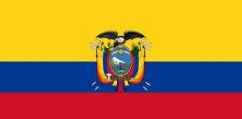The Secretariat of the Ramsar Convention on Wetlands of International Importance especially as Waterfowl Habitat (Ramsar Convention) reported that the Government of Ecuador has added four new Wetlands of International Importance.
Three are high Andean ecosystems at least, if not higher than, 3,000m above sea level and the fourth is an area of coastal mangrove forest in proximity to the city of Guayaquil.
 28 January 2013: The Secretariat of the Ramsar Convention on Wetlands of International Importance especially as Waterfowl Habitat (Ramsar Convention) reported that the Government of Ecuador has added four new Wetlands of International Importance. Three are high Andean ecosystems at least, if not higher than, 3,000m above sea level. The fourth is an area of coastal mangrove forest in proximity to the city of Guayaquil.
28 January 2013: The Secretariat of the Ramsar Convention on Wetlands of International Importance especially as Waterfowl Habitat (Ramsar Convention) reported that the Government of Ecuador has added four new Wetlands of International Importance. Three are high Andean ecosystems at least, if not higher than, 3,000m above sea level. The fourth is an area of coastal mangrove forest in proximity to the city of Guayaquil.
According to the Ramsar Secretariat, two of the new Ramsar Sites are part of the UN Educational, Scientific and Cultural Organization (UNESCO) Biosphere Reserve Podocarpus-El Cóndor (2007).
The first site, Manglares del Estuario Interior del Golfo de Guayaquil, is mainly constituted by mangrove forests, and plays an important role in controlling and preventing flooding, as well as in regulating climate. The habitat hosts several species that are endangered or critically endangered, as well as endemic species.
The second site, Reserva Ecológica El Ángel, is a National Protected Area and plays an important role as the source of several rivers that feed into the hydrological cycle of the region and benefit local populations. The site, which supports various threatened fauna species, is also a strategic link between the biodiversity Hotspots Tropical Andes and Tumbes-Chocó-Magdalena. Agricultural expansion, burning, hunting, fishing, and climate and hydrological changes are the main threats to the site.
The third site, Sistema Lacustre Lagunas del Compadre, part of the Podocarpus-El Cóndor UNESCO Biosphere Reserve, is a lake system formed by 50 glacial lagoons located in the central portion of the National Park Podocarpus. The site is the source of locally important rivers and supports some of the highest index of mammalian endemism in the country, as well as some avifauna species included in the International Union for Conservation of Nature (IUCN) Red List.
The fourth site, Sistema Lacustre Yacuri, is a National Park and part of the UNESCO Podocarpus-El Cóndor Biosphere Reserve Podocarpus-El Cóndor. The site consists of a lake system formed by 48 glacial lagoons, and is home to many threatened species and a paramo vegetation unique to the region. The site provides shelter to various endemic species threatened by continuous habitat loss.
Ecuador’s designations contribute to one of the goals contained in the Ramsar Convention’s Strategic Plan for 2009-2015, which is to reach a protected area of 250 million hectares by 2015. [Ramsar Press Release]